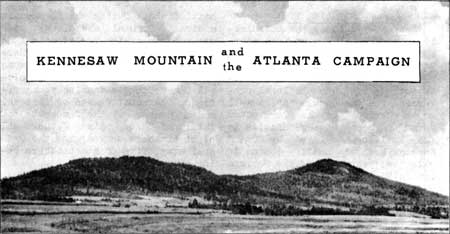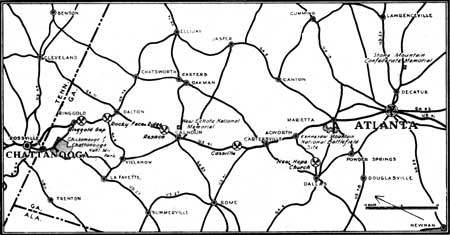|

Little Kennesaw, the Saddle and Big Kennesaw, as Seen from
the Site of General Johnston's Headquarters
By Bowling C. Yates, Jr.,
Superintendent,
Kennesaw Mountain National Battlefield Park, Georgia.
"Kenesaw, the bold and striking twin mountain, lay
before us, with a high range of chestnut hills trending off to the
northeast, terminating to our view in another peak called Brush
Mountain. To our right was a smaller hill, called Pine Mountain, and
beyond it in the distance, Lost Mountain. All these, though linked in a
continuous chain, present a sharp conical appearance, prominent in the
vast landscape that presents itself from any of the hills that abound in
that region. Kenesaw, Pine Mountain, and Lost Mountain form a triangle.
Pine Mountain, the apex, and Kenesaw and Lost Mountain the base,
covering perfectly the town of Marietta, and the railroad back of the
Chattahoochee. On each of these peaks the enemy had his signal station,
the summits were crowned with batteries, and the spurs were alive with
men busy in felling trees, digging pits, and preparing for the grand
struggle impending. The scene was enchanting; too beautiful to be
disturbed by the harsh clamor of war; but the Chattahoochee lay beyond,
and I had to reach it."
With these words General William T. Sherman gives a
brief but fitting description of Kennesaw Mountain battlefield near
Marietta, Georgia. Today the spurs are not alive with preparations for a
grand struggle as when Sherman saw them, but the natural beauty and
strength of the terrain are sufficient to attract the interest of the
many travelers of U. S. Highway No. 41 between Chattanooga and
Atlanta.
|
SPELLING IT
Kennesaw is today the officially accepted
orthography. The nearby town of Kennesaw (the "Big Shanty" of war days)
and the name of a residential street in Marietta both demonstrate the
local preference for the double "n". A well known survival of the form
often found on maps of the Sixties is the spelling employed by "Czar"
Kenesaw Mountain Landis (born in Ohio two years after the Georgia
battle), a former United States district judge who, since 1920, has been
commissioner for the major baseball organizations of America.
|
Sherman was not the only Federal soldier to be
impressed by this battlefield. During the engagement a direct frontal
assault was made on a part of the Confederate line defended by General
Cheatham. Here Federal losses were heavy and among them was a brigade
commander, Colonel Dan McCook, a dashing young officer, personal friend
of Sherman, and a member of the famous McCook family of Ohio. His father
and eight brothers served in the Federal army, five of his brothers
being generals.
Members of Dan McCook's brigade, impelled by the
desire to honor the memory of their fallen leader and comrades, formed
the Colonel Dan McCook Memorial Association. This group of Federal
soldiers, so far as is known to the writer, by acquiring the land over
which they fought on Kennesaw battlefield, was the first and only
organization of Civil War soldiers to become directly responsible for
the establishment of a national battlefield park. On December 26, 1899,
representatives of the association acquired title to the area where the
brigade had fought, and dedicated it for "commemorating the heroism of
that brigade, its associates and opposing troops of the battlefield at
Cheetham's Hill near Kennesaw Mountain, Georgia."
On February 8, 1917, Congress authorized the
establishment of Kennesaw Mountain National Battlefield Site. The act
specified the inclusion of the 60-acre tract which had been acquired and
developed by the Colonel Dan McCook Memorial Association. It was not
until 1928 that the association transferred the property to the United
States, so that a portion of the battlefield had been acquired,
dedicated and partly developed as a Civil War historic site over a
period of 28 years before the Federal government initiated the
establishment of a national battlefield park. This area was placed under
supervision of the War Department and was transferred in 1933 to the
National Park Service. Malcolm C. Tarver, Congressman for the Seventh
Georgia District, sponsored legislation in 1935 for considerable
acquisition and development of the lands, pursuant to which 2,000 acres
have been obtained, including the most historic portions of the
battlefield.
The Atlanta Campaign was an integral part of the
Federal military strategy for 1864. Grant was to resume the drive on
Richmond. Sherman, commanding Federal forces at Chattanooga, was to keep
the Confederate army in the west so busy that it could not reinforce Lee
and, as well, he was to destroy all factories, communications and
supplies which might prove of aid to the Confederacy.
On May 4 Sherman, with 100,000 troops, moved south
toward Dalton where Johnston had assumed a defensive position with
50,000 Confederates. During this campaign Johnston, ever on the
defensive, offered battle only when he had a definite advantage of
terrain. Unwilling to make frontal assaults under such conditions,
Sherman employed flanking tactics to force the Confederates out of
position so that he might strike them in motion. So skillfully were both
armies maneuvered that neither general could find a flaw in his
opponent's armor, but the weight of numbers forced the Confederates
deeper and deeper into their own territory with the result that by June
6 they were entrenched in the vicinity of Kennesaw Mountain, one hundred
miles south of Chattanooga.

(click on image for an enlargement in a new window)
The battle of Kennesaw Mountain began June 6 and was
ended by the Confederate withdrawal on the night of July 2. The
Confederates retired from one defensive position to another during the
engagement so that the battle was fought over an area of approximately
144 square miles. It is the final Confederate position held from June 19
to July 2, where the most critical engagements occurred, that has been
selected for development by the Service.
During the engagement, the opposing armies employed
every type of tactics used during the Atlanta Campaign: flanking
operations, direct frontal assaults, cavalry raids, and approach to
fortified lines by successive entrenchments. For that reason the
battlefield serves remarkably well for interpretation of tactics
employed throughout the critical campaign.
The interpretive program for the area is based on a
museum supplemented by field exhibits. The theme of the museum will be
the story of the battle of Kennesaw Mountain as related to the Atlanta
Campaign and Sherman's other campaigns in the west. This theme naturally
will develop Sherman's successful treatment of his problem of logistics,
the difficulty of maneuvering large bodies of troops over wooded and
hilly terrain, and an exposition of the tactics adopted by Sherman and
Johnston in the campaign.
The museum story will discuss not only the military
phases of the Atlanta Campaign; it likewise will emphasize other
far-reaching results of those operations. Sherman's capture of Atlanta
disrupted the communication and manufacturing system of the Confederacy
to such a large extent as to deprive the southern armies of supplies
which were indispensable. The fall of the city indicated to the civilian
population of the Confederacy that its armies were unable to defend
their own territory. The Confederacy had high hopes of foreign
recognition and intervention, but these were dashed completely by the
successful conclusion of the Atlanta Campaign.
The larger portion of the population in the north was
discouraged because the war was proving long and tedious with no
indication that Federal victories could bring it soon to an end. Running
for reelection in 1864, Lincoln was opposed by General McClellan who
advocated peace. McClellan was popular and unless a major Federal
victory occurred before the election it appeared probable that he would
be chosen for the Presidency. The timely conclusion of the Atlanta
Campaign provided the impetus needed to reelect Lincoln, and spurred the
north to the successful climax of the war.
The story to be told in the field will be given at a
few natural foci of historical interest. At each point there will be a
trailside exhibit of maps, photographs, and narrative, and from each
exhibit there will radiate a trail system designed to provide an
intimate picture of the operations. Due to the nature of the terrain and
the foresight of the engineers who laid out the fortifications for the
armies, excellent panoramic views will be obtainable at each of these
points. Restoration of fields and woods will be found desirable in areas
where such features were factors of considerable importance. The
fortifications used in the engagement were constructed mostly on ridges
which were rocky and wooded providing good visibility and protection for
the combatants. Because of the character of the soil, little attempt has
been made to cultivate these areas and the works are well preserved
today, presenting an appearance of grim utility combined with age.
Sherman marched from Chattanooga May 4 and entered
Atlanta September 2. The bivouacs and battlefields from May 19 to
September 2 are visible from the crest of Big Kennesaw Mountain so that
from that point a broad picture of a major portion of the Atlanta
Campaign can be given readily to visitors by employing the terrain
itself as a hugh relief. It is planned to construct observation
facilities and interpretive exhibits in order that this panoramic sweep
may be utilized to the utmost.
The acquisition and development of Kennesaw
battlefield and the interpretation of this battle of the Atlanta
Campaign, together with the development of the Atlanta Campaign Markers
at Ringgold, Dalton, Resaca, Cassville and New Hope Church, will bring
into proper light the thrust in the west which did much to restore the
nation to unity by hastening the end of the Southern Confederacy.
|

